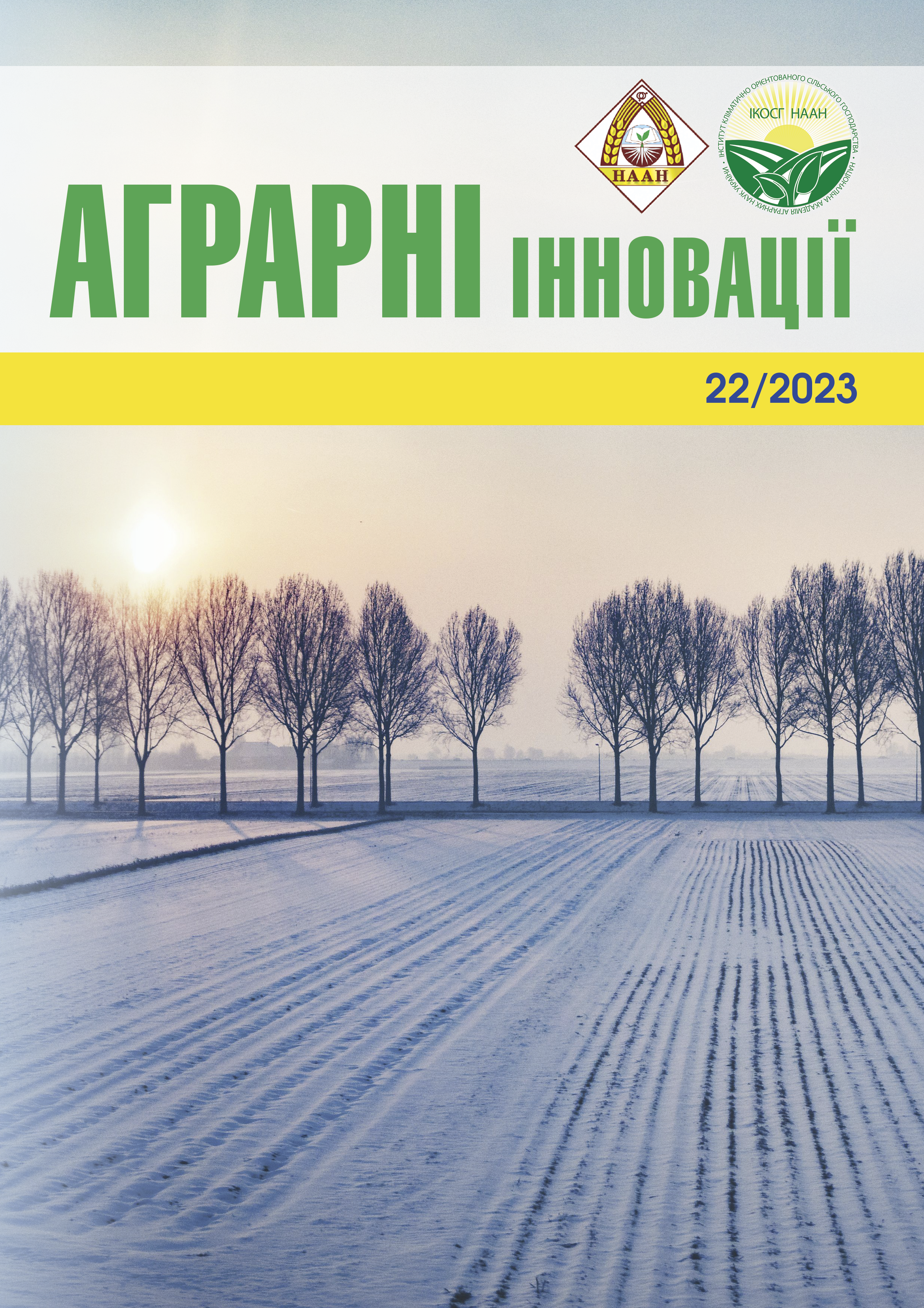FEATURES OF THE GROWTH OF APRICOT (PRUNUS ARMENIACA L.) OF DOMESTIC AND FOREIGN SELECTION DURING PRIMARY VARIETAL STUDY IN THE LISOSTEPPE OF UKRAINE
Abstract
Purpose. The purpose of these studies was to evaluate the strength of the growth of apricot trees of domestic and foreign selection and to recommend for production the varieties most optimal in terms of biometrics for intensive orchards. The research was carried out during 2021-2023 at the research site of the IH NAAS in the apricot plantations of the 2016, 2018 and 2019 planting years. 18 apricot varieties of domestic and foreign selection were studied, namely: Melitopolskyi rannii, Chervnevyi, Zaporozhets, Kostinskyi, Rodnik, Siaivo, Vynoslivyi, Kumyr, Robada, NGA19, Botsadivskyi, Osoblyvyi Denysiuka, Avrora, Cegledi Bibor, Jumbo Cot, Stepovyi, Faralia, Hargrand. For the control, domestic varieties were chosen, which are regionalized in the Lisosteppe zone, these are Melitopolskyi rannii (for the early-ripening group) and Syaivo (for the mid-late group). Tree placement scheme 5 x 2.5 m (planting year 2018) and 5 x 3 m (2016 and 2019). The shape of the crown is sparsely tiered. Rootstock – wild cherry seedlings. The soil was kept under black steam, dark gray, gilded, medium loamy on carbonates, typical for the research area. Agrotechnical care of garden plots was carried out in accordance with the recommendations of the IH NAAS regarding the cultivation of fruit-bearing plantations without irrigation in the Lisosteppe zone of Ukraine. Methods. Setting up and conducting experiments, basic records and observations were carried out in accordance with generally accepted methods. Statistical processing of data was done using a standard set of statistical functions of the Microsoft Excel program. The results of the study of biometric indicators of trees of apricot varieties of domestic and foreign selection are given. A significant relationship was established between the increase in the cross-sectional area of the trunk, the height of the trees and the growth of the yield of the studied varieties. NGA19 and Botsadivskyi are classified as medium-sized with a compact crown, which are quite suitable for creating intensive gardens and for use in breeding programs. The Chervnevyi, Rodnik and Kostinskyi trees need weak rootstocks and the formation of a more rarefied form of the crown. For other variants of the experiment, the choice of rootstock is not essential, if growth is restrained and the crown is thinned during annual pruning. Results. Studies of the growth characteristics of apricot varieties have shown that the smallest crown parameters have the varieties NGA19 and Botsadivskyi. It is advisable to use these varieties in programs of intensive creation of gardens and selection of low-growing apricot varieties. The early Chervnevyi, Rodnik, and Kostinskyi varieties require the selection of low-growing varietal rootstock combinations, as these variants were characterized by greater growth strength compared to others. For the rest of the studied varieties in the experiment, the choice of rootstock is not important, if the height of the trees and the habit of the crown are controlled by annual pruning. We established a reliable relationship between yield and tree crown height and volume, with correlation coefficients of 0.5387 and 0.5681, respectively (high level). A very high and highest correlation coefficient was determined between the yield and the cross-sectional area of the stem, which was equal to 0.8083. Findings. Mathematical modeling of the relationship between tree productivity and biometric characteristics of experimental plantations indicated that trees with a height of at least 2.6 m and a cross-sectional area of at least 20.2 cm2 provide the minimum economically valuable yield of 0.29 t/ha of apricots. According to the mathematical model, for each 1 cm2 increase in the cross-sectional area of the stem, the apricot yield increases linearly by 0.322 t/ha of fruits. In general, apricot productivity increases by 0.759 t/ha for every meter of increase from the mathematically justified minimum tree height.
References
2. Кондратенко П.В., Бублик М.О. Методика проведення польових досліджень з плодовими культурами: довідник. Київ : Аграрна наука, 1996. 96 с.
3. Кондратенко Т.Є. Практикум з помології: навч. посіб. Київ, 2000. 152 с.
4. Кіщак О.А., Кіщак Ю.П. Оцінка перспективних типів інтенсивних насаджень абрикоса (Armeniaka vulgaris Lam.) в Лісостепу України. Садівництво. 2017. Вип. 72. С. 73-79.
5. Омельченко І. К. Біологічні основи формування та обрізування плодових дерев і ягідних кущів. Київ: Аграр. наука, 2014. 256 с.
6. Барабаш Т.М. Основні напрямки створення інтенсивних садів черешні в умовах південного Степу України. Агроном. 2004. № 3 (5). С. 64-65.
7. Мельник О.В. Еволюція поглядів на формування і обрізування плодових дерев. Новини садівництва. 2005. Спеціальний випуск. С. 36.
8. Соболь В.А. Насадження абрикоса (Armeniaka vulgaris Lam.) на клонових і насіннєвих підщепах у правобережному Лісостепу. Садівництво. 2018.
Вип. 73. С. 49-57.
9. Андращук Олександр. Садимо абрикос. Садівництво по-українські. 2019. № 2. С. 66-69.
10. Бабій Ігор. Працюємо з кроною. Садівництво по-українські. 2016. № 13. С. 26.
11. Бенеш Давид. Витривалий абрикос. Садівництво по-українські. 2019. № 1. С. 62-65.
12. Головатий Петро. Обрізування: як, навіщо та коли? Садівництво по-українські. 2020. № 5. С. 40-41.
13. Ланар Людек. Нормуємо кісточку. Садівництво по-українські. 2020. № 1. С. 56-59.






